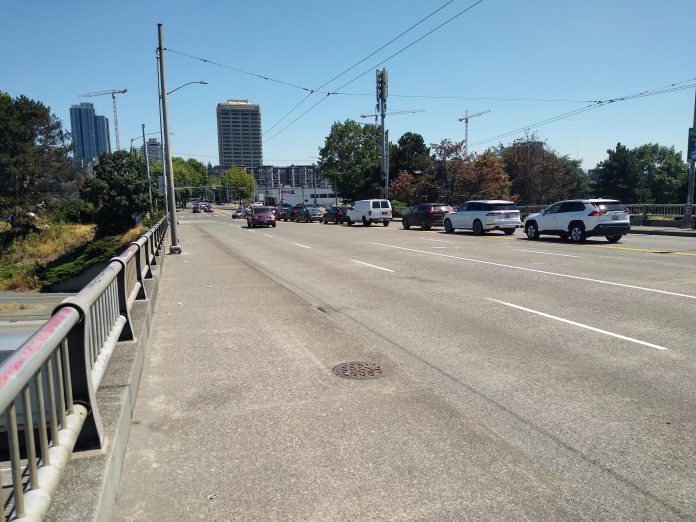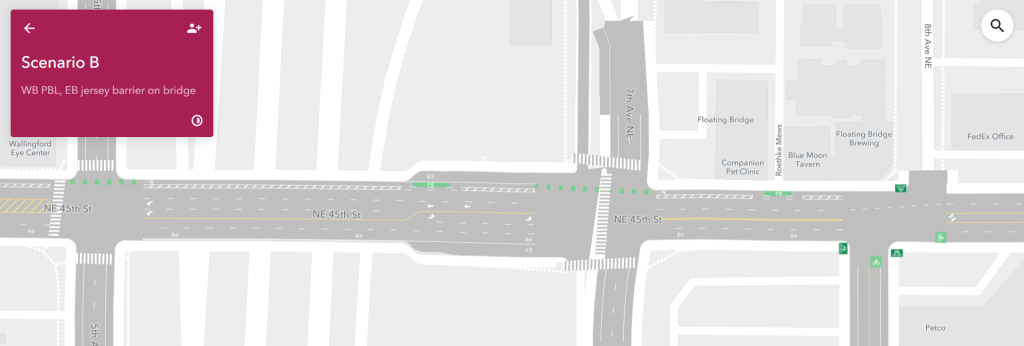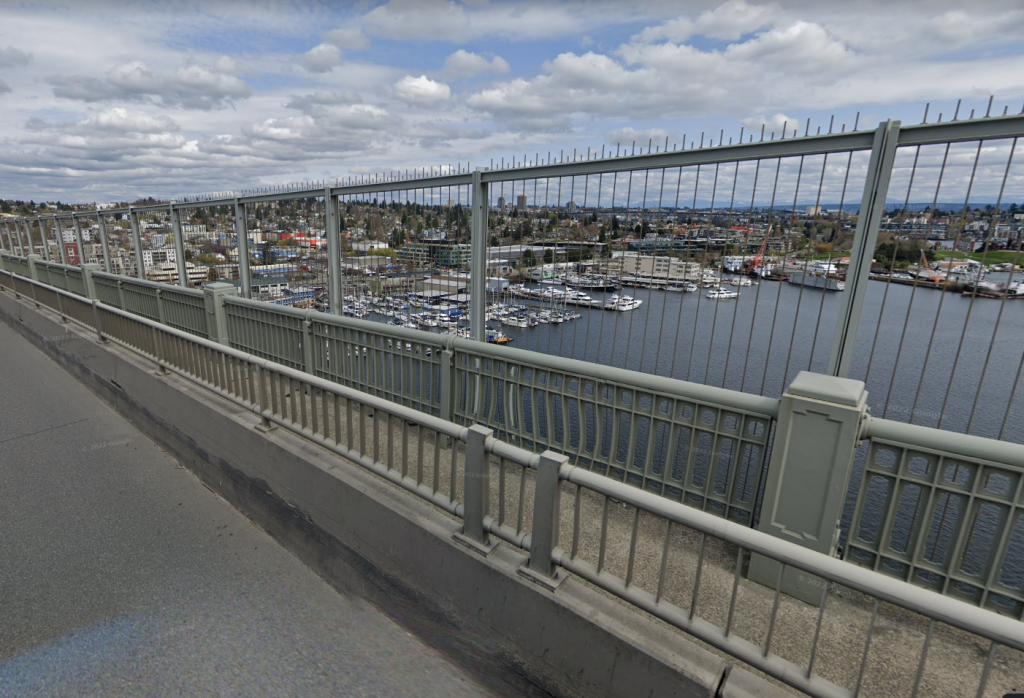
After years of advocacy pushing to create a safer environment for people walking and rolling across the NE 45th Street overpass between Wallingford and the U District, the Seattle Department of Transportation (SDOT) is moving forward with plans to improve the I-5 bridge with railings, rather than allocate any additional space on the bridge for people to walk or bike.
For two years in a row, the Seattle City Council has specifically allocated funds in SDOT’s budget to make the NE 45th Street overpass better. In 2020, the council approved $400,000 to ensure that the department would fully realize the promise that had been made to voters in 2015 when Move Seattle levy material stated that the levy’s passage enable it to “enhance the NE 45th St Corridor for pedestrians and cyclists between 4th Ave NE and Brooklyn Ave NE by the time University Light Rail opens in 2021,” even if a little late. After the Route 44 Transit-Plus Multimodal Corridor project left the overpass out of its plans entirely, the budget allocation included a proviso, or stipulation, that the funds couldn’t be used for improvements anywhere else.
In 2021, another proviso was added to those funds, further pushing the department to complete improvements. Both of those budget requests had been spearheaded by District 4 Councilmember Alex Pedersen, in an attempt to get SDOT to make good on its previous promises, a topic the councilmember frequently brings up as transportation committee chair.
A 2020 report authored by SDOT showed a westbound protected bike lane on the bridge was feasible (shown below), but in 2021 that option was taken off the table following negotiations with the Washington State Department of Transportation (WSDOT), with SDOT citing “major backups on the [northbound] off ramp which has been modeled to extend onto I-5” as a result of reallocating any additional space on the overpass.

That didn’t mean walking and biking advocates were ready to give up, however. The Seattle Bicycle Advisory Board joined calls from Cascade Bicycle Club, Seattle Neighborhood Greenways, and U District Mobility to create safe space for people biking.
“As it stands now, to access the U District from the Wallingford area via bike you must take a long detour or risk a terrifying ride in busy, aggressive vehicular traffic across the NE 45th Street bridge,” the bike board wrote in a letter this past November. “This is not an all ages and abilities biking network. Our communities need the planned protected bike lane and jersey barrier for people biking and walking across the NE 45th Street bridge.”
It looks like that Jersey barrier, a modular concrete or plastic barrier, may be the only thing that actually gets implemented. In an emailed statement, SDOT’s Mariam Ali confirmed that the department is designing a taller barrier for the I-5 side of the overpass and a lower railing on the NE 45th Street side to separate sidewalk users from traffic.
“We heard from community advocating for these improvements and they shared that they currently do not feel comfortable biking on the sidewalk due to the low existing railing height on the outside of the bridge and lack of physical barrier between them and moving traffic on NE 45th St,” Ali said. “In addition to the requests for a westbound protected bike lane, they said that the railing and fencing would help improve the experience for people walking and biking on the sidewalk.” She compared the design to the current infrastructure in place on the Aurora Bridge.

This new proposal, however, which may in fact narrow the usable space on the I-5 overpass’s sidewalks, due to the both the barriers themselves and the fact that users will want to stay at least a few inches away from them, is far from a done deal even with the money allocated by city council.
A preliminary cost estimate from WSDOT was $1.7 million, which is separate from the design costs that are utilizing that allocation. A grant application has already been submitted through WSDOT to cover the cost, but competition for state grants can be stiff. SDOT is developing the designs to 10% by this fall, which will lead to a new cost estimate. Councilmember Pedersen has been pushing to get that cost estimate so that he can include it in an updated budget amendment for 2023.
One reason additional space for walking and biking on the overpass was not able to survive appears to be the fact that SDOT doesn’t consider improving the NE 45th Street overpass to be a top priority, despite the important east-west connection it provides to the U District light rail station. A set of draft talking points was developed this May in response to Councilmember Pedersen’s requests for information on the project.
“Safety is a top priority for the department and we’d like to meet everyone’s needs in feeling safe and comfortable walking and biking around the city, [w]hich is why we were happy to meet the [Levy to Move Seattle] commitment through our Vision Zero Program…and Route 44 Transit + Multimodal Project,” SDOT’s Dawn Shellenberg wrote, “At the same time, it’s important to equitably invest where the highest need is based on our High Injury Map and the Bicycle and Pedestrian Safety Analysis findings, like along Aurora Ave and Rainier Ave S, while making system wide changes such as lowering speed limits and adding leading pedestrian intervals (including on each end of the bridge at 5th and 7th Ave NE].”
But clearly the long history of attempted changes to the NE 45th Street overpass has shown that it’s not a trade off between improving Rainier or Aurora Avenue and this stretch of roadway, but rather it’s a trade off between impacting nearby drivers and truly prioritizing walking and biking on the overpass. But the fact that getting close making the I-5 crossing between University District’s light rail station and a huge swath of the city on the west side of the highway comfortable and safe for people outside cars doesn’t rank as a high priority for SDOT without an incredible amount of outside pressure from both advocates and City Council is not encouraging.
A new set of railings on this highway overpass might make things a bit easier for people who already use the corridor, and that’s something to celebrate, but it’s clearly not going to be a significant game changer for safety and accessibility. A call for transformative change for NE 45th Street has been coming from the outside for quite a while, but it looks like it’s going to be a lot longer before it gets answered.
Ryan Packer has been writing for The Urbanist since 2015, and currently reports full-time as Contributing Editor. Their beats are transportation, land use, public space, traffic safety, and obscure community meetings. Packer has also reported for other regional outlets including BikePortland, Seattle Met, and PubliCola. They live in the Capitol Hill neighborhood of Seattle.

